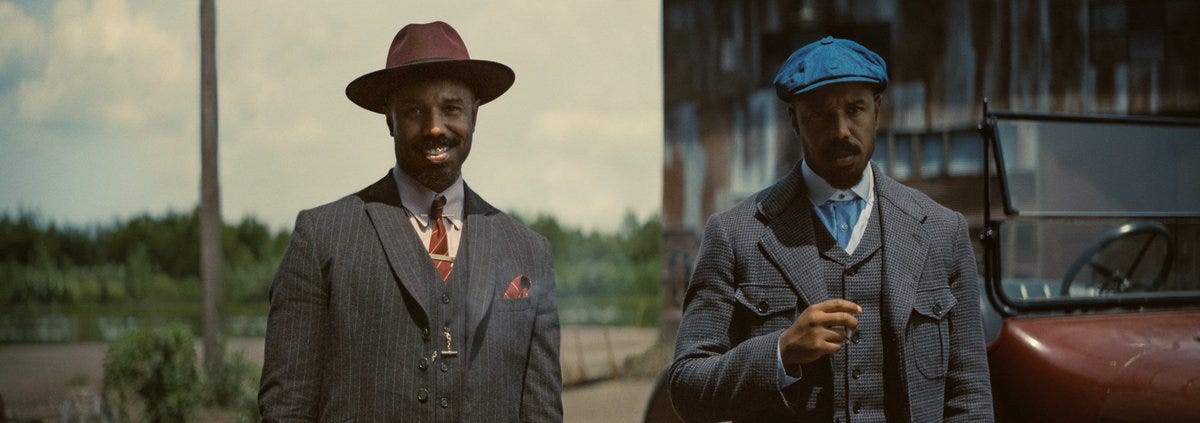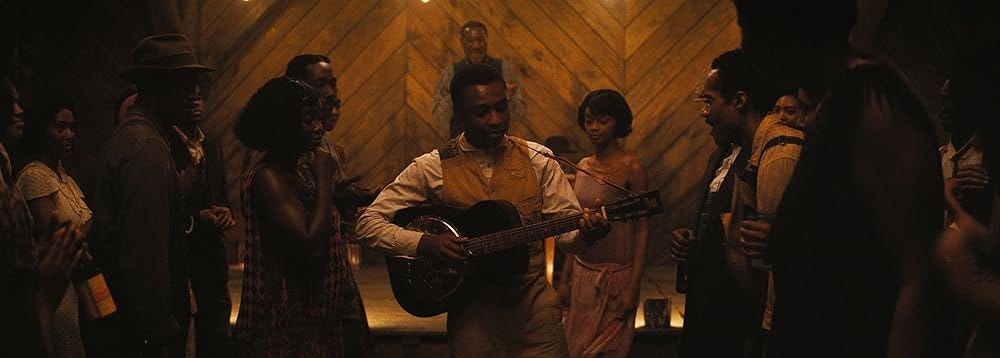*SPOILERS AHEAD* Read at your own risk…
With Sinners, filmmaker Ryan Coogler returns from his tenure with Marvel with something refreshingly original. Starting like a period drama, it swept itself into a thriller, and to complement the film’s many twists and turns, every sprouting plotline was preceded with the clever planting of a seed. However, it was not just an exercise in genre; it was an expression of transcendental thoughts delivered with absurdist metaphors.
The cinematic language of Sinners was extremely focused and concrete. Not at all ambiguous, the arbitrary editing and generic cinematography evidenced not cinematic illiteracy but rather a different set of priorities: Sinners intertwined spectacle with story, building from a rich thematic palette and benefitting from a well-distributed budget.
Following two twin brothers returning to their rural hometown on the Mississippi delta, they set their eyes on opening a juke joint. It was their next big goal after having seen part of the world as soldiers in World War I and spent the last chapter of their lives as Chicago bootleggers. Returning home with their fortune, the dressed-to-kill Smokestack twins (both played by Michael B. Jordan) were contrasted against their rural surroundings as they used their power and wealth to jumpstart their new business venture.
Meanwhile, a dark undercurrent lurked throughout the film, centered around music as a portal to traditions of past and present, a gateway for good and evil spirits alike. This supernatural undertone was juxtaposed by Smoke, who told his former lover, Annie (Wunmi Mosaku), he had been around the world and saw no supernatural governing force — only structures power and control.

Contrary to what some critics might claim, Sinners was not merely an exercise in genre. Instead, Coogler used genres to explore his themes. Beginning like a period drama, a sinister undertow fermented beneath the film’s quickly developing plot, themes and characters. The cadence at which these devices developed was acutely swift, and Coogler seemed to understand every one of his motifs and how to deliver them. Shirking heavy-handedness, a myriad of themes were merely implied, built on hints dropped in moments of dialogue or through visual juxtapositions. Although dialogue was the main expositional vehicle, moments of visual grandeur became thematic vehicles, and in spite of its apparent ability to “bend” many different genres, Sinners remained focused on its set of themes and was rather unafraid to explore them through metaphor.
For example, this was a “vampire film,” but only once it reached a certain point. The characters armed themselves with garlic and wooden stakes, and the theme of sexuality inherent to American vampire films was very present. Although the vampires attempted to lure the living with promises of immortality, they also dangled promises of equality — this was what made the vampires in Sinners stand out. Among the overarching themes of racial injustice hinted at throughout the film, the term “equality” seemed all too sinister when it rolled from the tongue of a vampire.
This brought the entire idea of “equality” into question and revealed Coogler’s intent to attack the notion entirely. When people were “converted” to vampirism, they embodied a Dionysian emotion of liberation. Drunk on watered-down wine (in this case blood), they encouraged the non-converts to join them, tempting them with immortality and shared consciousness. To them, conversion was a no-brainer. By placing vampirism and equality hand-in-hand, Coogler spoke to an audience familiar with “equality” as an individualist concept, which is reinforced by the concept of vampirism among its converts as a “melting pot” of sorts. It was not aligned with any one race or creed; instead, vampirism was like the same crushing individualism we have today — one which disintegrates true identity and disembodies the outliers. In a sense, these vampires resembled forces of gentrification and the bureaucratic system which adopted the superficial rhetoric of “equality” without correcting its internal structures rooted in something oppressively archaic.
This was why the vampires required an invitation. Although seeming like the corniest priestly rhetoric (“Don’t invite the devil into your heart!”), these invitations revealed the vampires as lacking omnipotence despite their power. Like the political powers that be, they relied on cunning and manipulation to achieve their goals, such as using a daughter to threaten a mother so as to force an invitation from her lips. This was all they needed to enter the juke — all they needed was the verbal acceptance of their victims before they infiltrated, like the binding signature on a document or a blood pact.
The idea of gentrification was shown not only through the vampires but also through the Smokestack twins, who returned from Chicago dressed to the nines. However, this mentality deeply affected only one of the twins: Recall the scene at the beginning of the juke joint’s opening night, when a man approached the bar, ordered a 50-cent whiskey, but only had 30 cents and two seemingly wooden tokens to pay for it. Although Annie accepted this payment, one of the twins scorned her for doing so. However, this juke was their attempt to connect with the community, Annie and the other twing reminded him. This was not Chicago, it was a community space, and in order to find harmony with the community, they had to embody the local standard.
Still, both twins showcased the theme of class transcendence. Not only were they wearing the finest clothes, but their pockets were also full of cash, which they constantly used to their advantage. Money was always the ticket out of a situation, or the ticket into one — until the final scene, where Smoke was on the other end of his own bargain.
Smoke accepting his fate was the conclusion of a profound character arc, for not only did he embrace death, he also had to kill his other “self” to get there. Stack was an early martyr in their fight against vampirism, but it was essential for Smoke’s journey. Despite their typically unanimous outlook, Smoke and Stack still had their differences, but their severance was necessary. After returning from the war and after a career as bootleggers, both twins now faced a new challenge: Influence from outside their rural community. To see his other half succumb to the new temptations of reality was the first step in the divorce between Smoke and gentrification. It was a messy divorce and amounted in a sort of half-suicide as he was forced to kill Stack.
It was after the vampires all burned that Smoke faced the final challenge. The former Klan member who sold the place to the twins returned with his former Klan buddies, but they were no match for Smoke. This was when he was placed on the other end of his own bargain — the Klan member bleeding out in front of him offered him a presumably large amount of money if he spared his life. Smoke’s response: gunfire. He slowly accepted his fate where he lay. His death was a rebellion against the lynch-hungry Klan members, against the immortal vampires.

It was instead the immortality of the blues which persisted through history. Although the final shot of Sammie playing guitar before a live audience 60 years after the events of the film was seemingly stamped onto the end, it reinforced the theme of immortality in a positive way, for music was the most powerful force throughout the film. When Sammie (Miles Caton) conjured the devil with his music, it did not stop him from growing old as a blues player, nor did it stop Slim (Delroy Lindo), the pianist, in his own past. Referring to the devil as an “old friend,” Slim established a recurring theme of “devils” attempting to “steal” the blues, a musical tradition which originated in Black communities but was popularized by white musicians.
Despite the antagonizing force taking the form of a horde of vampires, they were powerless beyond the boundaries of music. It was the scene where Sammie played at the juke joint that spoke volumes beyond the film’s conclusion and closing credits. A moment combining musical traditions both past, present and future, it boasted a raw kinetic force which offered the film a profound cinematic strength beyond its literary themes. This scene epitomized cinematic grandeur being harnessed for genuine meaning rather than pure spectacle, for it harmonized both traits equally. Like the blues, this scene is immortal.
It was a revelation of the new cinema, one that exposed multivalent truths. Although cinema both past and present offers a nuanced glance into the reality of their themes and settings, Sinners explored them with great efficiency. Coogler’s new film was cinematically unoriginal, but that is because originality was not his goal. Instead, his goal was to unpack the vast potential of cinema and understand how certain motifs can be explored using the medium’s versatile appendages. Perhaps to dub this as “the new cinema” would be misleading, but the fact of the matter is this: Coogler’s new film is a breath of fresh air in an industry which churns out content rather than cinema.
The best thing about Sinners? It was not heavy-handed. It was simultaneously subtle and over-the-top while keeping its cards close to its chest, proof that such profound themes can be communicated in simple, fun terms. It was a refreshing entry into contemporary cinematic canon from a filmmaker fresh off a Marvel kick. It was cinema.


Such an amazing review, loved it!
Very good analysis! Those who think this is just a From Dusk Til Dawn ripoff have missed the point entirely. Its depth is profound and you have touched on all of its merits.